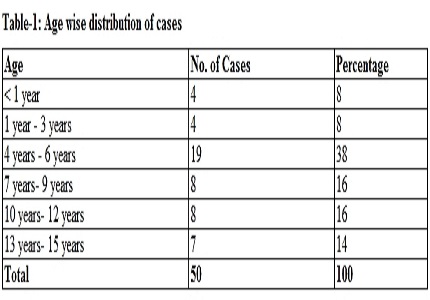Biofilm production by uropathogens causing catheter associated urinary tract infection
Abstract
Background: The microbial populations within urinary catheter frequently develop as biofilms, directly attaching to the surface of catheters. Bacteria in biofilm are protected from antimicrobial chemotherapy as well as host defence mechanisms, establishing chronic persistent infections, septicemia and death if not treated.
Material and Method: The present study, includes 200 patients, catheterized for >48 hours at CIMS, Bilaspur. Urine samples were collected and inoculated in nutrient agar, blood agar and MacConkey agar plates and identification done as per standard procedure. This study was conducted to detect biofilm formation ability of uropathogens by two different methods (Tube and Congo red agar method) and compare their antibiotic sensitivity by using Kirby-Bauer disc diffusion method.
Results: Out of 200 urine samples significant bacteriuria were detected in 148(74%) of samples and no growth found in 52(26%) samples and 14 samples showed growth of 2 microorganisms. A total no. of 162 microorganisms were isolated from 200 urine samples. Among these 162 isolates E. Coli was 29.62%, Pseudomonas aeruginosa 11.72%, Klebsiella sp 18.51%, Citrobactor sp 7.40%, Staphylococcus aureus 3.08%, and Coagulase negative Staphylococci 11%. Among these 162 isolates, a total of 91(56.17%) isolates showed biofilm production. Percentage of biofilm formation was highest in P. aeruginosa (63.15%).
Conclusion: Tube test method was found to be more reliable method. The in vitro antibiotic susceptibility pattern of biofilm producing organisms showed less sensitivity as compared to non-biofilm producing organisms.
Downloads
References
What are Biofilms? Montana State University, Center for Biofilm Engineering: Biofilm research & education relevant to industry, health, and the environment. Website available at: http://www.biofilm.montana.edu/biofilm-basics.html
Drekonja DM, Johnson JR. Urinary tract infections. Prim Care. 2008 Jun;35(2):345-67, vii. doi: https://doi.org/10.1016/j.pop.2008.01.001.
Trautner BW. Management of catheter-associated urinary tract infection. Curr Opin Infect Dis. 2010 Feb;23(1):76-82. doi: https://dx.doi.org/10.1097%2FQCO.0b013e328334dda8.
Oelschlaeger TA, Dobrindt U, Hacker J. Virulence factors of uropathogens. Curr Opin Urol. 2002 Jan;12(1):33-8.
Forbes BA, Sahm DF, Weissfield AS. Bailey and Scott’s Diagnostics Microbiology, 10th ed, St. Louis, Misssouri, USA: Mosby Inc.;1998.
MacFaddin J. Biochemical Tests for Identification of Bacteria. 3rd ed. Philadelphia: Lippincott Williams and Wilkins; 1976.
Afreenish Hassan, Javaid Usman, Fatima Kaleem, Maria Omair, Ali Khalid, Muhammad Iqbal. Evaluation of different detection methods of biofilm formation in the clinical isolates, Braz J Infect Dis 2011;15 (4).
Clinical and Laboratory Standard Institute.Performance Standards for Antimicrobial Suseptibility Testing. Vol. 1, No. 1, M2 A9. Pennsylvania, USA: Clinical and Laboratory Standard Intitute ; 2007.
Pradeep Kumar SS, Easwer HV, Maya Nandkumar A. Multiple drug resistant bacterial biofilms on implanted catheters - a reservoir of infection. J Assoc Physicians India. 2013 Oct;61(10):702-7.
Taiwo SS and Aderounmu AOA. Catheter Associated Urinary Tract Infection: Aetiologic Agents and Antimicrobial Susceptibility Pattern in Ladoke Akintola University Teaching Hospital, Osogbo, Nigeria. African Journal of Biomedical Research, 2006; 9: 141 - 148.
Mahabubul Islam Majumder, Tarek Ahmed, Delwar Hossain, Mohammad Ali, Belalul Islam and Nazmul Hasan Chowdhury. Bacteriology and Antibiotic Sensitivity Patterns of Urine and Biofilm in Patients with Indwelling Urinary Catheter in a Tertiary Hospital in Bangladesh, J Bacteriol Parasitol 2014, 5:3.
Asha B Patil, Shobha D Nadagir, Rashmi Dhaduti, Praveen AJ, Syeda Fasiha Mohammadi, Lakshminarayana SA, Namratha WN.Catheter-associated urinary tract infection: Aetiology, ESBL production, and risk factors. JIACM 2014; 15(1): 22-51.
Dr. S. G.Kulkarni1, Dr. S. H. Tali, Dr. Manjiri Naik, Dr. Amit Kale. Profile of Urinary Tract Infection in Indwelling Catheterized Patients. Journal of Dental and Medical Sciences 2014;13 (4): 132-138.
S. Abaeze et al., The prevalence of urinary catheter related infections in federal medical centre Abeokuta Nigeria. Int J Pharm Biomed Sci 2011, 2(3), 81-85.
S. Niveditha, S. Pramodhini, S. Umadevi, Shailesh Kumar, and Selvaraj Stephen .The Isolation and the Biofilm Formation of Uropathogens in the Patients with Catheter Associated Urinary Tract Infections (UTIs). J Clin Diagn Res. 2012 November; 6(9): 1478–1482.
Onipede Anthony, Oyekale T Oluwalana, Olopade Bolatito, Olaniran Olaniran, Oyelese Adesola, and Ogunniyi Titus. Urinary Pathogens and Their Antimicrobial Susceptibility in Patients with Indwelling Urinary Catheter. Sierra Leone Journal of Biomedical Research. June, 2010 Vol. 2 (1) pp. 47-53.
Gamal Fad Mahmoud Gad, Mohamed Ali El-Feky, Mostafa Said El-Rehewy, Mona Amin Hassan, Hassan Abolella, and Rehab Mahmoud Abd El-Baky.Detection of icaA, icaD genes and biofilm production by Staphylococcus aureus and Staphylococcus epidermidis isolated from urinary tract catheterized patients .J Infect Dev Ctries 2009; 3(5):342-351.
S. Pramodhini,S. Niveditha, S. Umadevi, Shailesh Kumar, and Selvaraj Stephen,Antibiotic resistance pattern of biofilm forming uropathogens isolated from catheterized patients in Pondichery, India. Australasian Medical Journal AMJ 2012,5(7)344-348.
Nermeen Mahmoud Ahmed Abdallah, Shereen Bendary Elsayed, Manal Mohamed Yassin, Mostafa and Ghada Metwally El-gohary. Biofilm forming bacteria isolated from urinary tract infection, relation to catheterization and susceptibility to antibiotics. International Journal for Biotechnology and Molecular Biology Research 2011; 2(10): 172-178.
Rohan Chaudhari, Anjali Deshpande, Subhash A Angadi and Geeta V Koppikar (2004): A Preliminary Study of Catheter Associated Bacteriuria, Bombay hospital journal. 2004; 46 (03).
G Reid PhD, R Charbonneau-Smith RN, D Lam MSC, Yun Suk Kang, student, M Lacerte MD, KC Hayes PhD. Bacterial biofilm formation in the urinary bladder of spinal cord injured Patients. Paraplegia 30 1992; 711-71.
Henry F. Alavaren, Jodor A. Lim, Melecia Antonio-Velmonte, and Myrna T. Mendoza, Urinary Tract Infection in Patients with Indwelling Catheter. Phil J Microbiol Infect Dis 1993; 22(2):65-74.



 OAI - Open Archives Initiative
OAI - Open Archives Initiative


